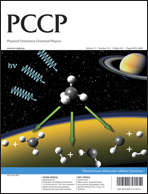The oxidation reaction dynamics of the gas-phase yttrium atoms by oxygen molecules was studied under crossed-beam conditions. The product YO was detected using a time-of-flight mass spectrometer combined with laser single-photon ionization. An acceleration lens system designed for the ion-velocity mapping conditions, a two-dimensional (2-D) detector, and a time-slicing technique were used to obtain the velocity and angular distributions of the products. Two ionization wavelengths were used for the internal (vibrational and/or electronic) energy selective detection of YO. The single photon of the shorter wavelength (202.0 nm) can ionize all states of YO(X 2Σ, A′ 2Δ, and A 2Π), while electronically excited YO(A′ and A) are dominantly ionized at a longer wavelength (285.0 nm). Time-sliced images were converted to the velocity and angular distributions in the center-of-mass frame. The general features of the velocity distributions of YO, determined at two wavelengths, were well represented by those expected from the statistical energy disposal model. The forward–backward symmetry was also observed for two images. These results suggest that the reaction proceeds via long-lived intermediates, and that this mechanism is consistent with previous chemiluminescence/LIF studies.

You have access to this article
 Please wait while we load your content...
Something went wrong. Try again?
Please wait while we load your content...
Something went wrong. Try again?


 Please wait while we load your content...
Please wait while we load your content...